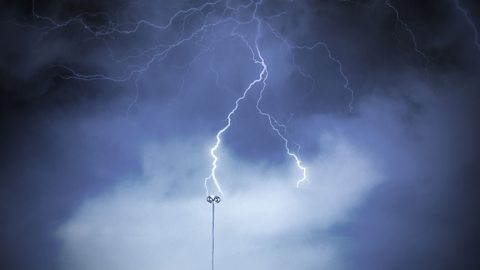Key points
Resistance (shown as R) is a measure of how difficult it is for current to flow. Resistance is measured in units called ohms (Ω).
The amount of ≥¶≥Ð∞˘∞˘±≤‘≥ŸÃ˝(±ı)Current is¬Ýa¬Ýflow of charges.¬ÝIt is measured in amps (A). flowing in a circuit is affected by the resistance of that circuit.
Each component in a circuit has a resistance.
Resistance can be calculated using the equation: Resistance = potential difference √∑ current
Video - Resistance
Sometimes, a bulb might not light up as brightly as you’d expect it to.
Because something else in the circuit is partially blocking or resisting the flow of electricity.
Resistance is a measure of how hard it is for electricity to pass through a component.
And it happens because the negatively charged electrons are colliding with the positive ions in the metal, transferring energy to them. The more collisions, the higher the resistance.
When we briefly connect this circuit with just wires, we can see that the current is about six amps.
But when we add in a length of special resistance wire, made of copper and nickel, the current drops to two point eight amps.
The collisions inside the wire make the atoms vibrate more, increasing their temperature which can make the wire glow.
Longer wires mean more collisions, so there is higher resistance.
Thinner wires mean more collisions, and higher resistance, too.
Resistance is also affected by the type of material, and the temperature.
We can calculate the resistance of different components using readings of current and potential difference from the ammeter and voltmeter.
Resistance, measured in ohms, is equal to the potential difference in volts, divided by the current in amps.
So the resistance of this wire is nought point one five volts divided by two point two five amps, so nought point nought seven ohms.
And you can do that for any component that you put in the circuit, like a bulb or a motor.
Can you answer these questions based on the video?
What happens to the current in a circuit when you add a piece of resistance wire?
What is the unit of measurement for resistance?
The current decreases.
Resistance is measured in ohms (Ω).
The effect of resistance on current
When a circuitAn electrical circuit is made up of components, which are connected together using wires. is connected a current flows - electronsThese are one of the particles that atoms are made from. They¬Ýhave a negative charge.¬ÝCharge can be positive or negative.¬ÝFor example,¬Ýprotons are positively charged and electrons are negatively charged.¬Ý move through the wireA thin piece of metal which electrical current can flow through. Wires are used to connect components together. Wires are often covered in plastic insulation. Wires are also known as cables or leads. and componentA part of a circuit eg a battery, motor, lamp, switch or wire.. As the electrons move, they collide with ions, which causes resistance (R)How difficult it is for current to flow..
The more resistance there is in a circuit, the less current will flow.
The resistance increases when you add more components in seriesA way of connecting components in a circuit. A series circuit has all the components in one loop connected by wires, so there is only one route for current to flow. . For example, the resistance of two lamps in series is greater than the resistance of one lamp. Less current will flow through them and they will not light up as brightly.
Resistance is measured in units called ohms, which is represented by the symbol Ω (an uppercase Greek letter omega). For example, a resistance of 10 ohms can be written as 10 Ω.
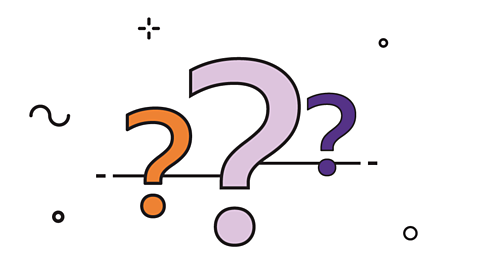
Did you know?
All wires and components have resistance, though usually the resistance of wires is small enough to ignore.

Resistors
It can be useful to add resistance to a circuit. For example, increasing resistance can make a motor spin more slowly, or make a lamp light less bright. A component called a resistor can be added in series to a circuit to increase the total resistance.
The image shows different types of resistors.
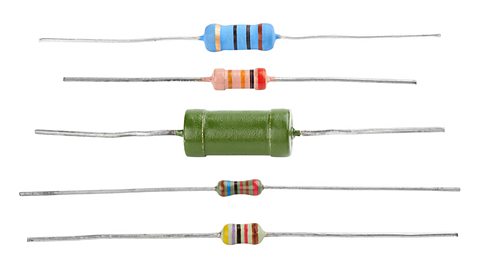
The circuit symbol for a resistor is a rectangle. These rectangles both represent resistors.
Calculating resistance
Potential difference (p.d.) is the amount of energy transferred by each unit of charge passing between two points of a circuit. The unit for potential difference is the volt (V). For a given potential difference, the larger the resistance the smaller the current that can flow.
To find the resistance (R)How difficult it is for current to flow. of a component we need to know the potential difference (V) across it and the current (I) flowing through it. We can then use the formula to calculate the resistance:
\(Resistance = \frac{potential~difference}{current}\)
The equation can also be written using symbols: \(R = \frac{V}{I}\)
Example
A circuit contains a battery, a resistor and an ammeter. The battery has a potential difference of 12V, and the current flowing is 2A.
What is the resistance of the circuit?
\(Resistance = \frac{potential~difference}{current}\)
\(Resistance = \frac{12~V}{2~A}\)
\(Resistance = 6~Ω\)
A circuit contains a cell, a lamp, an ammeter and a voltmeter. The current flowing in the circuit is 3 A and the potential difference across the lamp is 6 V.
What is the resistance of the lamp?
\(Resistance = \frac{potential~difference}{current}\)
\(Resistance = \frac{6~V}{3~A}\)
\(Resistance = 2~Ω\)
Test your knowledge
Quiz
Play the Atomic Labs game! gamePlay the Atomic Labs game!
Try out practical experiments in this KS3 science game.

More on Electricity
Find out more by working through a topic
- count1 of 11
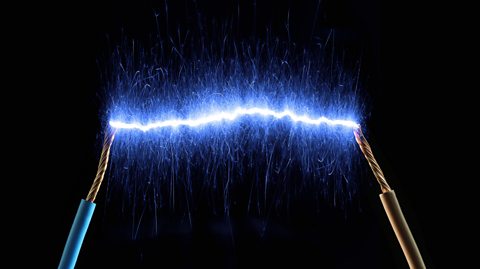
- count2 of 11
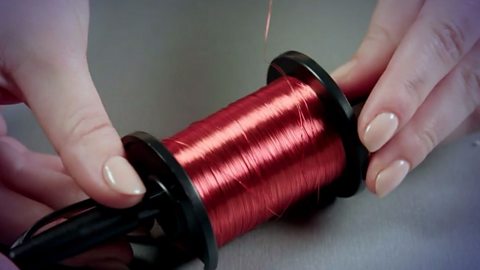
- count3 of 11

- count4 of 11
